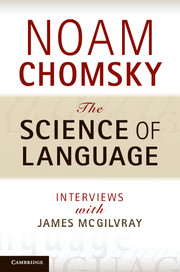Book contents
- Frontmatter
- Contents
- Introduction
- Part I The science of language and mind
- 1 Language, function, communication: language and the use of language
- 2 On a formal theory of language and its accommodation to biology; the distinctive nature of human concepts
- 3 Representation and computation
- 4 More on human concepts
- 5 Reflections on the study of language
- 6 Parameters, canalization, innateness, Universal Grammar
- 7 Development, master/control genes, etc.
- 8 Perfection and design (interview 20 January 2009)
- 9 Universal Grammar and simplicity
- 10 On the intellectual ailments of some scientists
- 11 The place of language in the mind
- 12 Chomsky's intellectual contributions
- 13 Simplicity and its role in Chomsky's work
- 14 Chomsky and Nelson Goodman
- Part II Human nature and its study
- Appendices
- Commentaries
- Glossary
- Bibliography
- Index
7 - Development, master/control genes, etc.
from Part I - The science of language and mind
Published online by Cambridge University Press: 05 June 2012
- Frontmatter
- Contents
- Introduction
- Part I The science of language and mind
- 1 Language, function, communication: language and the use of language
- 2 On a formal theory of language and its accommodation to biology; the distinctive nature of human concepts
- 3 Representation and computation
- 4 More on human concepts
- 5 Reflections on the study of language
- 6 Parameters, canalization, innateness, Universal Grammar
- 7 Development, master/control genes, etc.
- 8 Perfection and design (interview 20 January 2009)
- 9 Universal Grammar and simplicity
- 10 On the intellectual ailments of some scientists
- 11 The place of language in the mind
- 12 Chomsky's intellectual contributions
- 13 Simplicity and its role in Chomsky's work
- 14 Chomsky and Nelson Goodman
- Part II Human nature and its study
- Appendices
- Commentaries
- Glossary
- Bibliography
- Index
Summary
JM: Who was the person who did the interesting work on the eye and the PAX-6 gene; I forgot.
NC: Walter Gehring.
JM: Gehring in Switzerland. That kind of work might throw quite a different kind of light on the question of how a system that had Merge built into it . . .[C]
NC: His work is extremely interesting; and basically, what he shows – I don't have any expert judgment, but it seems to be pretty well accepted – is that all visual systems (maybe even phototropic plants) seem to begin with some stochastic event that got a particular class of molecules into a cell – the rhodopsin molecules that happen to have the property that they transmit light energy in the form of chemical energy. So you have the basis for reacting to light. And after that comes a series of developments which apparently are very restrictive. There's a regulatory gene that seems to show up all over the place, and the further developments, according to his account, are highly restricted by the possibilities of inserting genes into a collection of genes, which probably has only certain physical possibilities . . .
JM: the third factor . . .
NC: . . . yes, the third factor, which gives you the variety of eyes. That's very suggestive; it's quite different from the traditional view.
JM: Does it have any bearing on language?
NC: Only that it suggests that there is another system that seems to have powerful third factor effects.
- Type
- Chapter
- Information
- The Science of LanguageInterviews with James McGilvray, pp. 46 - 49Publisher: Cambridge University PressPrint publication year: 2012



